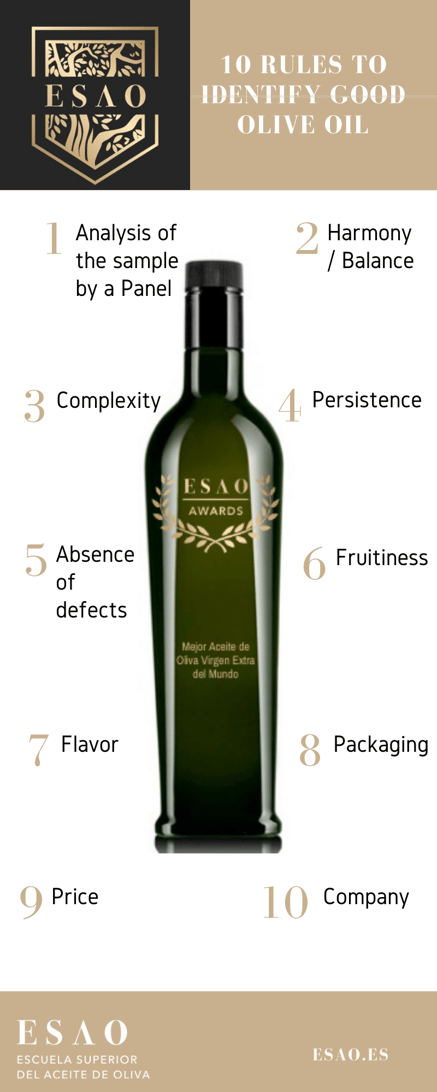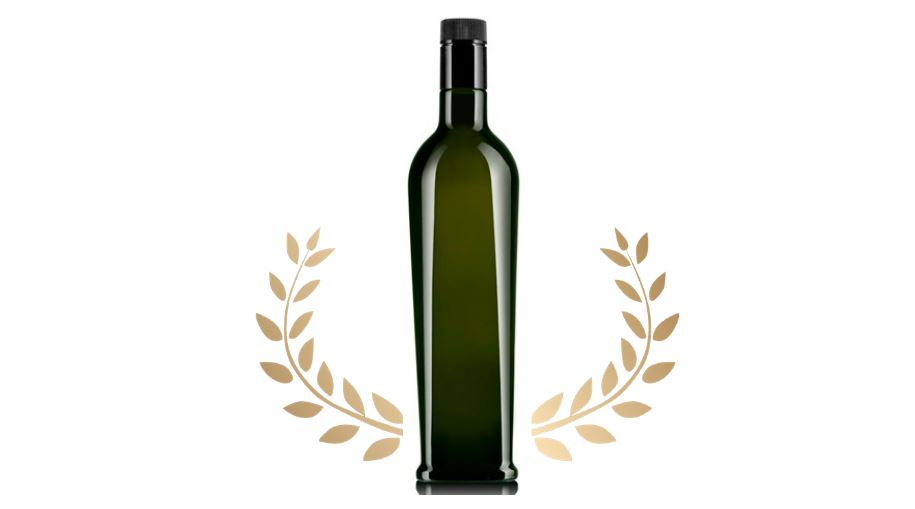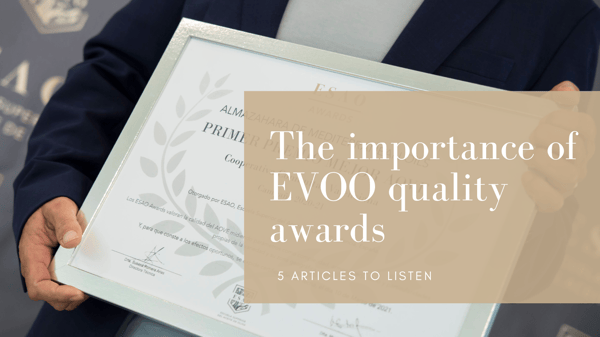Listen to this article
When it comes to evaluating and knowing which is the best extra virgin olive oil in the world, a series of criteria must be taken into account as professionally as possible.
Which oil is better?
We can all recognize when an oil has been carefully elaborated, the result of careful olive growing, from a healthy fruit, with a meticulous production process.
Of course, to be able to recognize it, you need to have a previous experience in olive oil tasting, you need some basic notions about what a fresh, clean EVOO is, what are the defects and how to recognize them, etc. With some basic notions on these issues, we could come to recognize whether or not we are looking at a good oil.
However, when it comes to fine-tuning, or scoring to rate an EVOO sample, we must take into account what process is followed and what specific criteria we will assess.
There are many degrees between good and bad. In the search for the best oil in the world, we have a great tool that is the test panel, a scientific method and an instrument that allows us to precisely measure the quality of virgin olive oil.
Currently it is possible to establish quality standards, in order to approach in the most objective way possible when establishing which is the best extra virgin olive oil in the world or which oil is better than others.
You have to be aware that we are talking about the best oil in the world, this award is definitely of great importance. We will not forget to be aware of what was discussed in the article on our blog, the award for the best olive oil in the world or for the best Spanish olive oil.
There are also rankings that classify the best oil in the world and that annually edit their lists. One of the strongest rankings is the EVOO World Ranking , that includes those EVOOs that have participated in any of the competitions held worldwide during the year.
10 rules to identify good olive oil
Let's see the decalogue or the 10 basic ESAO rules on which oil is better?

Rule 1:
Analysis of the sample by a Panel
You have to know that it is not the opinion of a single person. When it comes to fine-tuning oil tasting, and scoring it, the right choice is the one made by a tasting panel. This is by a group of experts, previously trained in the sensory analysis of virgin olive oil.
The professional assessment of a virgin olive oil is carried out by a group of people who have experience in tasting oils. It should not be the opinion of a single person that tells us that we are facing the best EVOO, since sometimes this person can be influenced, for example, by her personal tastes, or particular interests of some kind.
If the EVOO sample is carried out by a group of people, the evaluation will be fair and impartial.
Sommelier tasting EVOO during ESAO session
Rule 2:
Harmony / Balance.
Harmony is one of the most valued characteristics at the moment in extra virgin olive oil samples. Especially when we talk about analysis for awards.
When you smell an extra virgin olive oil, and later taste it, you want there to be no highlights or notes that stand out too much from each other.
If I taste an EVOO, and it has a light fruity, for example, then when it goes to the mouth I don't want it to be intensely spicy and bitter.
The taster's expectation when smelling a sample must be met as far as possible when that sample goes to the mouth.
In short, harmony is the balance between all the components that make up the aroma and flavor of extra virgin olive oil. Balance and harmony are very important parameters and a basic rule in the best EVOOs in the world.
When we talk about great balance, we mean that all its notes and sensation are in their proper measure and there are no great highlights. For example, an EVOO that has a light fruity, i.e., that the aroma is not very intense and that it is difficult for us to get aromatic experiences and volatiles, it cannot later have an intense bitterness and / or spiciness when we put it into the mouth.
The balance in extra virgin olive oil is that one in which its notes are in ranges and scores of similar intensities.
If we find a light fruity and an intense bitter, sometimes we can be in front of unbalanced samples. A sample that we are going to value as the best oil or not in the world, will be penalized when it is unbalanced and there is no balance.
To assess balance, what is sought in the best EVOO in the world is that all aromas and flavors coexist in perfect harmony. The more harmonic an EVOO is, the higher its score will be.
Rule 3:
Complexity
When we talk about complexity, we talk about aromas and flavors, with different notes.
When smelling a sample of EVOO, we like its aromas to evoke different descriptors, that it smells of both fruit and grass.
The extra complex virgins are those that have a multitude of nuances.
Complexity, more than a characteristic, is considered a virtue of the aoves, and in most cases, the complexity comes from the variety of olives.
Complexity means that an EVOO has a very diverse range of flavors behind it.
When we, tasters, use the term complex it is because we have several different sensory notes in front of us, which evoke different experiences.
We find ourselves in the same sample with sensations of fruit and vegetables, or with herbaceous as well as floral sensations ... after all, a combination of sensations and experiences that will surprise us. These are the EVOOs that that usually surprise us positively.
Complexity can also come to us from flavors and aromas, "different or suggestive", but always with the common characteristic of memories of nature.
The more complex an EVOO is, the higher its score.
Rule 4:
Persistence
The persistence in the EVOO tasting is the duration of the flavors in the mouth. More specifically, it would be how long the flavor of an extra virgin olive oil lasts in the mouth, once we have tasted it.
When you taste an extra virgin olive oil, you want all the positive attributes that it has to stay in your mouth as a set of pleasant sensations that you do not want to go away quickly.
You want to continue noticing all those positive sensations that a good EVOO leaves us, and we value that these sensations are not fleeting but that they persist in the mouth once we have tasted the virgin olive oil.
A good persistence in the EVOO will have a higher score than an EVOO without persistence
Rule 5:
Absence of defects
In any case, the absence of defects is an intrinsic characteristic of a sample that we are going to evaluate for an award.
If, for example, we are at the ESAO Awards, in the first round what we do is discard all those samples that have a defect.
When we talk about a good extra virgin olive oil, it must have a total absence of defects or anomalous notes.
Sometimes, when we talk about anomalous notes we can be confused with notes from unknown varieties or to which we are not used.
For this reason, it is important before discarding any sample or penalizing it, to see that the defect is corroborated both in the nose and in the mouth, while we are not dealing with a totally unknown variety.
However, when we are used to and well trained in tasting, it is easy to distinguish whether it is a defect or a varietal characteristic.
Rule 6:
Fruitiness
When we talk about fruitiness, we refer to the amount of aroma that a sample of virgin olive oil gives off.
When we rate and look for the best oil in the world, we see that a common characteristic of all of them is that they have an intense fruitiness.
Intense fruitiness means that as soon as we approach or uncover the sample, the aroma of the EVOO is perceived.
It is valued positively when the sample gives off the aroma, releases the volatiles and surrounds the glass with its characteristic smell of early, fresh and freshly harvested EVOO.
This does not mean that light or medium fruitiness is penalized. The different fruity are very important in EVOOs, since there will be times when we want a medium fruity evoo and at other times we want the fruity to be light, depending for example on what food we are going to work with.
However, when we talk about Awards EVOOs, it is important that the fruitiness be as high as possible. When we refer to an extra virgin olive oil having great fruity, it is when we notice the force with which the aromas and flavors surprise us.
Rule 7:
Flavor
When we refer to flavor, in extra virgin olive oil, we refer to the overall experience perceived at the end of the tasting. It would be like the final result of the combinations of all the sensations perceived in the oral and nasal cavities: the aroma, the taste and the tactile or kinesthetic sensations.
In particular, the non-volatile ones, it seems that they are mainly responsible for the taste and tactile sensations. They contribute to create the psychological-sensory base of the 'flavor' on which the aroma sits and builds and hence the importance it has the knowledge, not only of the volatile composition, but also of the taste and tactile sensations to get to understand the flavor.
In the end, the flavor will be decisive for the best extra virgin olive oil in the world.
Rule 8:
Packaging does matter
Although packaging has nothing to do with sensory analysis, it is essential to be aware that the appearance of a bottle matters.
In various studies we have been aware that on many occasions, a customer's purchase decision is because: "the bottle looked pretty." That is, due to a factors.
Taking care of what a great EVOO surrounds, is as important as that the product itself has a high quality.
The set will be the one that causes us those experiences that we seek when it comes to an outstanding product.
It is not permissible that we are before the best EVOO in the world in terms of organoleptic analysis, and then this great work is accompanied by a transparent plastic bottle, for instance. This would break the expectations of any buyer and possibly make it difficult for them to recognize that it is the best oil in the world.
Rule 9:
Price does matter.
Like packaging, when we talk about the price of a high-quality product, it must also be accompanied by a price that is consistent with the product.
The best EVOO in the world cannot be priced below the average for high-end EVOO. This would break the mental structure and expectations once again of the buyer.
An outstanding EVOO is intrinsically linked to low yields, and meticulous and especially careful work. These two aspects undoubtedly make production significantly more expensive. These parameters have to be reflected in the price, because as we have said before, this will be what finally brings harmony and fulfillment of expectations.
We can not be in front of the best extra virgin olive oil in the world and see that its price is below the average of its competitors.
Rule 10:
The company does matter
In the same way that packaging and price remain outside the sensory or organoleptic analysis, the company would also undoubtedly remain as an external aspect to the purely product quality.
However, when we are facing the best EVOO in the world, we are not talking about something casual. Following the requirements to be qualified as the best EVOO in the world, at ESAO, we take into account that it is the winner of the first three most important competitions in the world, and that it is the winner in more than one. Having a track record in quality assures us that there is control of the process.
The fact that the company behind this EVOO, be it a producer or cooperative, has a good, professional, fast, translated into English, updated and responsive website are some of the characteristics that will give us that set that we all want from the best EVOO in the world.
In the same way as a professional website, we will seek that the company has the certificates related to food safety and basic quality and that they confirm that indeed one EVOO is better than another.
This decalogue will be the one that determines which oil is the best and especially which oil is the best in the world.
.png)






